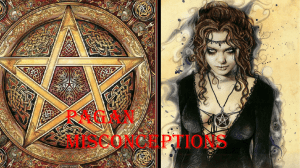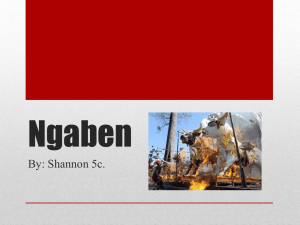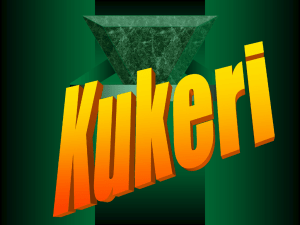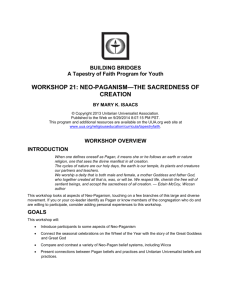Link button - Police Pagan Association
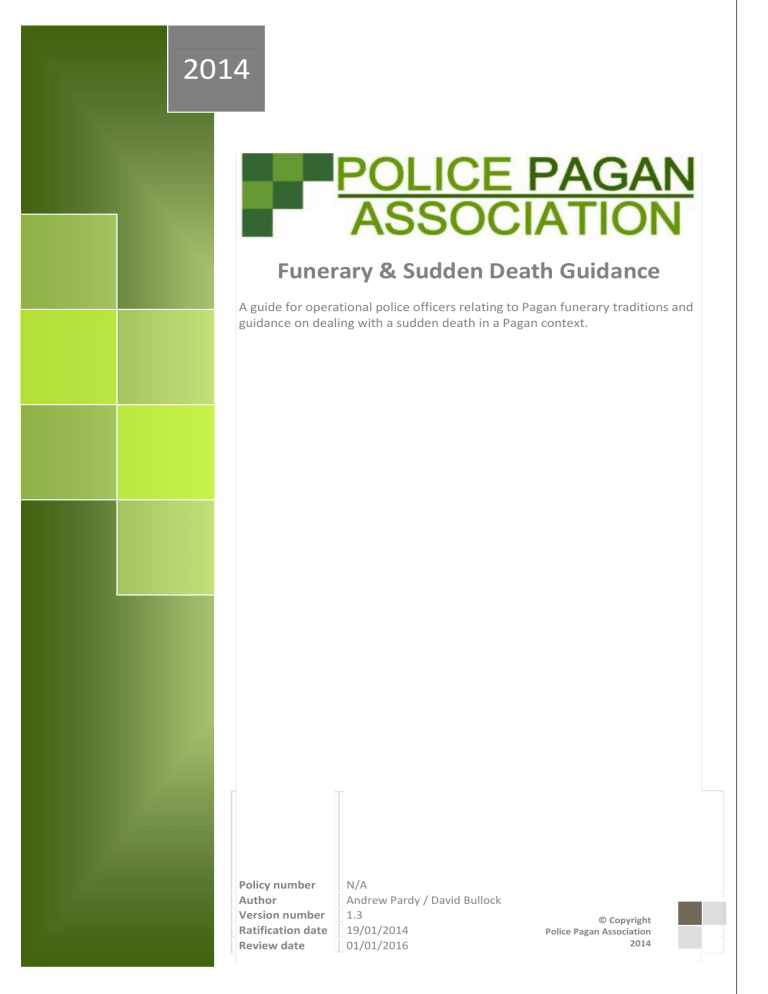
2014
Funerary & Sudden Death Guidance
A guide for operational police officers relating to Pagan funerary traditions and guidance on dealing with a sudden death in a Pagan context.
Policy number N/A
Author Andrew Pardy / David Bullock
Version number 1.3
Ratification date 19/01/2014
Review date 01/01/2016
© Copyright
Police Pagan Association
2014
CONTENTS
Section 1
Location
Disposal
Offerings, Personal Items and Ritual Tools
Funerary Ritual
Mourning
Section 2
Sudden Death
Appendix A
Ritual Weapons
Appendix B
Pagan Symbols
Appendix C
The Tyr Rune
Section 3
Document Control
Page 3
Page 3
Page 4
Page 4
Page 5
Page 6
Page 7
Page 8
Page 9
Page 10
SECTION 1
Location
Most Pagan funerals will take place outdoors, either in an established memorial site or a location of significance to the deceased, such as a natural place which the individual shared an affinity with or where they regularly held or took part in ceremonies.
Pagans may use areas to which the public are granted access for funerary rituals and may not make the landowner aware of their presence for such events, but are unlikely to overstep the usual bounds of access granted to the public.
Pagan funerals which take place indoors will either be held at a non-denominational chapel or, in some cases, the home of the deceased.
Disposal
Cremation is the preferred funeral option of 70% of the UK population (1), and remains the most popular within the Pagan community. The cremation will usually form part of a ceremony held at a non-denominational chapel registered as a crematorium, but a further ceremony in which the ashes are scattered will usually take place in a location of significance to the deceased.
Some Pagans will opt for a ‘green’ burial, in which a ceremony is conducted by a nondenominational minister or the high Priest/Priestess of the order or coven of which the deceased was part. A green burial will involve the use of a biodegradable coffin, in which the deceased is placed after being wrapped in a woollen shroud. This type of burial will usually occur in a non-denominational woodland cemetery, and often the traditional headstone is replaced by a tree planted on or at the head of the grave. In the event of a Pagan requesting a green burial the body is not embalmed or treated with chemicals, but may be washed with salt water prior to the interment.
Approximately 150,000 people are buried in cemeteries and churchyards each year (2) and, although discretionary provision exists that allow part of a cemetery to be consecrated for use by particular denominations or religious bodies (3), Pagans are usually buried in a nondenominational cemetery or on private land, such as the garden of a privately owned house.
Burials would only ever be carried out with the consent of the landowner, and in any case would adhere to the relevant legislation covering burials in areas other than a designated cemetery (4).
(1) Page 5, Burial Law and Policy in the 21 st Century – Home Office consultation document (2004)
(2) Page 25, Burial Law and Policy in the 21 st Century - The Way Forward – Ministry of Justice document (2007)
(3) Page 22, Burial Law and Policy in the 21st Century – Home Office consultation document (2004)
(4) Burial Act 1857, Burial Laws Amendment Act 1880, Public Health Act 1984.
3
Offerings, Personal Items and Ritual Tools
As with many other burials or cremations, personal items belonging to the deceased and offerings may be left by attendants, and in some occasions interred or cremated along with the deceased. Some of these items will hold a ritual significance, and these should be treated with the same respect as offerings left on any grave or burial site. Although ritual knives and tools may be used during the funerary ritual it is unlikely that any such items will be left on a crematory or burial site; it will be more likely that such personal and important tools are interred or cremated with the deceased, or are handed down to a family member, a close friend, or a member of their order or coven.
The type of items used at a Pagan funerary ritual will vary depending on the path of the
Pagans with whom the deceased was associated. The ritual itself will almost always involve an altar as a focal point within a defined area, which may or may not be physically marked by objects such as candles. The ritual tools used in Pagan rituals each serve a particular practical or representational purpose, and have often been blessed or dedicated and therefore should not been handled by anyone else unless explicit permission has been given or if it is deemed absolutely necessary to do so.
Most Pagans will own a ritual dagger known as an Athame, and Druidic Pagans are also likely to own a ritual sickle known as a Boline. Some Heathen Pagans may own a ritual sword and/or a ritual dagger, and may refer to the latter as a Seax; pictorial examples of these can be found in Appendix A. Legislative guidance on the usage of sharply bladed or pointed articles in a public place provides a defence if whoever is found in possession of such an article can prove that they using it for religious reasons (5).
Funerary Ritual
Pagan funerary rituals can vary dependant on the location of the ritual, those involved, and any requests made by the deceased prior to their passing. Heathen Pagans prefer cremation but some, as with any other community, may still opt for burial. Heathens and Hindus are currently lobbying government in order to have funeral pyres recognised as a lawful funerary process, but these remain illegal unless it is carried out at sea, such as at the funeral of Peter Boyle, who died in Glasgow in 2009 and was set out to sea in a burning
Viking longship (6).
(5) Section 139 of the Criminal Justice Act 1988
(6) Largs Viking Festival 2009
4
Funerary Ritual
Druidic Pagans are the most likely to opt for burial over cremation. When possible and practicable the deceased is usually made available to view by colleagues and relatives for a day before their interment. The funerary ritual is often carried out in a forested area by members of the order to which the deceased belong; they will often be dressed in ritual robes which are usually, but not always, white.
Most Pagan funerary rituals will involve some sort of singing, chanting and/or the reading of text; this may be accompanied by the partaking of wine or mead and the consumption of food such as bread. It is common for Pagans to cast a ritual circle and call on the four directions of the compass or the four elements during a ceremony. The ritual may consist of periods of meditation and reflection and will sometimes involve the burning of incense or oils and a ritual fire. Given the British climate and the comparative rarity of the practice, it is unlikely that Pagans will be naked at funerary rituals. Pagans do not carry out animal sacrifice or unlawful harm on others at any ritual. Pagans are inclusive in all aspects of their faith, so it will not be uncommon for non-Pagans and those of other faiths to be present at
Pagan funerals.
Mourning
Although Pagans accept death as a part of the sacred life process and welcome it when appropriate, Pagans do not rejoice at the death of a loved one. Different Pagan paths have differing views on what the afterlife is, and although there is no concern with regards to punishment in the afterlife it is natural that the deceased will be missed and mourned for a time. Many Pagans believe that the spirit of the deceased departs upon death, but they remain an integral part of their community. The recently deceased and familial ancestors are remembered at the Pagan festival of Samhain, when candles are often lit in their honour and stories of their lives orated at social gatherings.
In some Pagan households it remains a tradition to include the spirit of the recently deceased at a ritual meal, in which they will set a place and served food along with others at the table. Ancestors are of particular importance to those of the Heathen tradition.
© Copyright Police Pagan Association 2010
5
SECTION 2
Sudden Death
When attending the sudden death of a member of the Pagan community or a Pagan household, officers should avoid touching any items which appear to be of ritual significance to the deceased.
The presence of ritual items such as Athames should be considered sympathetically when considering the circumstances of a sudden death; all efforts should be made to avoid offence when speaking to relatives or friends of the deceased who may or may not know of their Pagan faith.
Ritual items should not be used to harm another, and the seizing of such items from a Pagan household should only be undertaken if deemed absolutely necessary, and with the permission from the family of the deceased if appropriate.
Family members will usually be aware of the funerary wishes of the deceased. If a ‘green’ burial is requested then the undertaker and morgue technicians should be made aware so that the corpse is not treated with chemicals. The preparation of a Heathen corpse would usually include the trimming of the fingernails and toenails due to the legend of Naglfari, a boat made of the uncut nails of the dead which carries the enemies of the Gods into battle at Ragnarok – the end of the world.
Ritual jewellery should not be removed without the consent of the family of the deceased. In most
(but not all) cases a Wiccan will wear a pentacle, a depiction of the moon or The Goddess; a Heathen will wear an inverted hammer or a Valknut; and Pagan Druids will wear a depiction of the Arwen; pictorial examples of these can be found in Appendix B .
A rare Heathen custom exists whereby a dying Heathen Pagan may mark their skin with the Rune of the Norse God Tyr, or request another to do so; a pictorial example of the rune can be found in
Appendix C . This may be marked by drawing or cutting the symbol into the skin. This is because some Heathens believe that their spirit will depart through the wound, although rare in the UK it may inadvertently appear to be suspicious or even the cause of death; friends or family will likely have knowledge of this procedure, should it be encountered.
The family of the deceased may request that ritual items be kept with them, especially Heathens, who believe that entry into Valhalla is only granted to those with a weapon in their hands. Whilst not always practical, efforts should be made to observe this important aspect whenever possible.
© Copyright Police Pagan Association 2010
6
© Copyright Police Pagan Association 2010
Appendix A
ATHAME
An example of an Athame, a ritual dagger possessed by most Pagans. It is usually dedicated to the owner, and is an important ritual tool.
BOLINE
A Boline is a ritual sickle, usually (but not exclusively) possessed by Druidic
Pagans. It is usually dedicated to the owner, and is a practical and ritualistic tool.
SEAX
The Seax is a traditional single-edged knife of Northern European origin. It is usually used by Heathen Pagans in much the same way as an Athame, but is also a practical tool.
SWORD
Ritual swords can be possessed by those following any of the Pagan paths, but are more prevalent in Heathen and
Druidic orders. Many Pagan covens will own a sword for the purpose of important rituals; many are not suitable for other uses, and are often blunted for safety.
7
Appendix B
PENTACLE
The pentacle is the most commonly worn and recognised Pagan symbol, and is worn by Pagans of all paths, but most commonly by Wiccans. The Pentacle may be worn as a pendant around the neck or on a charm bracelet worn around the wrist or ankle.
TRIPLE MOON
This symbol, which represents three aspects of the moon, is often worn by
Dianic Wiccans, and is more prevalent with female practitioners.
© Copyright Police Pagan Association 2010
THE GODDESS
The Goddess is often portrayed in a simple fashion, in keeping with the original depictions found on ancient artefacts. The figure is always feminine, but can be in a variety of poses.
NORDIC HAMMER
The Hammer, most commonly worn by
Heathen Pagans, is a representation of the hammer of Thor, and is referred to as Mjolinir. Heathen Pagans may wear jewellery in the form of a pendant, torque or armband.
8
Appendix B
VALKNUT
The Valknut is another Heathen symbol, but is often misunderstood, as some white supremacist groups misrepresent such symbols as part of their cause. For
Heathen Pagans the Valknut represents strength and integrity.
AWEN
The Awen is the sacred symbol of the
Druidic Pagans, and represents Divine
Inspiration.
© Copyright Police Pagan Association 2010
Appendix C
THE TYR RUNE
This is a basic example of the Nordic Tyr
Rune, which may be found on the person of a Heathen Pagan, either drawn or tattooed onto or, on rare occasions, cut into their skin.
9
Date
18/07/11
08/09/12
19/01/14
Compliance
Diversity
Health and Safety
Data Protection
Human Rights
Freedom of Information
Information Management
Version
1.1
1.2
1.3
SECTION 3
Document Control
Auditor
PS 1158 Andrew Pardy
PS 1158 Andrew Pardy
Date
19/01/14
19/01/14
PS 1158 Andrew Pardy
PS 1158 Andrew Pardy
Summary of Changes
Current
Current
Current
19/01/14
19/01/14
10
BLANK PAGE
11

